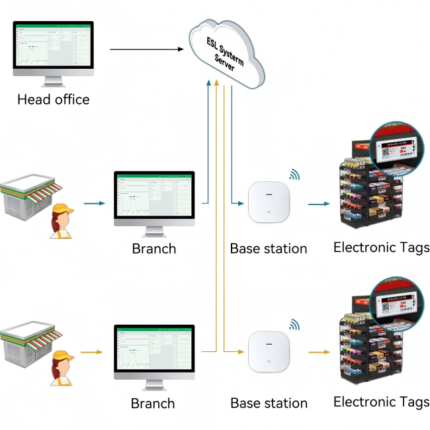
ESL replace paper price tags
The digital transformation of enterprises relies heavily on the effective digitization of display.
Electronic shelf labels (ESL) are an ideal choice to meet this requirement, as they come with remarkable features such as real-time data synchronization,
Paper-like display, significant cost savings, and low power consumption.As a result, they are capable of replacing paper in a wide array of application scenarios.


Functions of
Electronic Shelf Label
- SID Electronic Shelf Labels (ESL) are an ideal digital wireless display system that can quickly and efficiently wirelessly update the content on shelf signage, including product pricing and product related information.
- ESL display information is managed in real time by a computer control system over a wireless network.
- Supermarkets, grocery markets, pharmacies, warehouses and any industry that relies on paper to display prices can switch to ESL
Working Principle
Production information that stored in the database is
encoded and processed by Hipoink ESL system, for those product
information that needed to be updated will be broadcast
through Ethernet to Hipoink station and finally transmitted to
the target ESLs of the shoppingmall (or stores)

Comparison of the advantages of
ESL Solutions Compared With Peers
Our side
- Support full and off-site backup of data
- Use transmitters to deal with power outages and network outages in an emergency.
- A single base station refreshes 30,000 price tags at one time without any abnormalities or failures.
- Use AES128 data encryption, dynamic key, and package it into pictures for delivery
- The fastest speed is 1 second, the fastest in the industry. Refreshing 5,000 price tags at one time takes as little as 19 minutes.
- Power consumption in sleep mode is just 1.46μA, reduced when inactive.
- Auto-switch templates based on product status, like from "normal sales" to "out of stock."
- If the delivery fails, it will be automatically re-delivered after 2 minutes until it succeeds.
VS
- Data backup
- Emergency
- Reliability
- Encryption method
- Refresh speed
- Power consumption
- Auto match template
- Data resend mechanism
Peers
- Supports partial backup, but not off-site backup
- Unable to support
- A single base station cannot support too many price tags, and batch refreshes are prone to data loss.
- Directly issue
- Some take 8 seconds, 24 seconds, or even 30 seconds, and some even take about 20 minutes to refresh 200 price tags.
- Some peers Power consumption up to 9.12μA
- Unable to automatically match
- No such mechanism
ESL Application Scenario

Factory storage

Medical treatment

Supermarket

Manufacturing

Smart office








